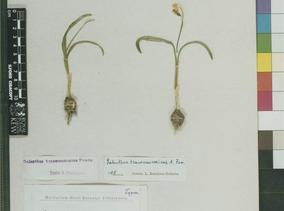You are here
About Galanthus and Sternbergia
Galanthus Wild Species
Galanthus transcaucasicus Fomin
SUMMARY
From: Davis (1999). Permission has been granted by the author.
G. transcaucasicus Fomin, in Fomin & Woronow, Opred. Rast. Caucas. Krym. 1: 281 (1909).
G. artjuschenkoae Gabrieljan.
G. caspius (Rupr.) Grossh.
BULB ovoid to ± spherical, 1.5–3 x 1–3.1(–3.5) cm. SHEATH 3–7 x 0.5–0.7 cm. Vernation supervolute. LEAVES ± linear to narrowly oblanceolate (broader in the middle to upper third), or very narrowly linear-lanceolate (slightly broader in the middle to lower third), narrowed at the base, at flowering 7–20(–27) x (0.6–1–)1.5–2(–2.3) cm, after flowering developing to 10–18 x (1–)1.5–2.3(–2.5) cm, recurving at maturity; midrib conspicuous; margins flat to slightly undulate; apex obtuse to acute-obtuse, flat to very slightly hooded; surfaces smooth, sometimes with two (rarely four) longitudinal folds (leaves bent slightly upwards or slightly downwards); upper and lower surfaces slightly different in colour, upper surface medium- to darkish green, slightly shiny to matt, lower surface light to pale green, often shiny. SCAPE (2.5–)4–12(–17) cm long, green. PEDICEL 16–30 mm long. OUTER PERIANTH segments obovate to narrowly obovate, or ± elliptic, 15–25(–30) x 7–11 mm, slightly unguiculate. INNER PERIANTH segments obovate to oblanceolate, or ± obtriangular, 7–12 x 4–6 mm, each segment with a sinus and an apical ± U- to V-shaped green mark; inner face of each segment with a faint green mark similar to the mark on the outer face. ANTHERS tapering to a long point. CAPSULE ± spherical, 10–17 mm in diameter. SEEDS unknown.
Examination of populations in situ and study of specimens in local herbaria in Azerbeijan and
Iran may significantly alter some of the dimensions given in this description.
Flowers between December and April in nature; January and March in cultivation.
Notes: Galanthus transcaucasicus was named by the Russian botanist A.V. Fomin from material collected near Lenkoran in Azerbeijan. The epithet transcaucasicus means, in Latin, ‘from Transcaucasia’, a geographical region south of the Caucasus which includes Armenia, Azerbeijan and Georgia. This species of Galanthus has not been collected with any frequency, or studied at any length in the wild or in cultivation, and a result remains one of the least well known. In Snowdrops and Snowflakes Sir Frederick Stern (1956) placed G. transcaucasicus into Species non satis notae (‘Species not well known’), and had to rely on Losina-Losinskaya’s Flora of the USSR (1935) for information on it, as living material had not been introduced at that time. It was probably not until the 1970s that G. transcaucasicus came into cultivation in Europe, and even then it was mainly confined to botanical gardens. During the 1990s there were several further introductions, but the species remains very rare in cultivation, and only one or two specialist bulb nurseries are able to offer it for sale.
Galanthus transcaucasicus has supervolute vernation, rather broad leaves (c.1–2.3 cm wide), medium- to darkish green, and a single green mark at the apex of each inner perianth segment. The upper leaf surface is shiny to very slightly glaucous (matt green). Galanthus transcaucasicus is similar to G. woronowii and G. ikariae. It differs from G. woronowii in having darker leaves, and an inner perianth segment mark that is a rather regular U- to V-shape, not straight at the end nearest the base as in most G. woronowii. Galanthus transcaucasicus has a mark covering less than half of the inner perianth segment, as opposed to a mark that usually covers half or more of the segment, as in G. ikariae. The leaf anatomy of G. transcaucasicus is also quite different from that of G. ikariae. The distribution of G. transcaucasicus does not overlap with that of G. woronowii or G. ikariae, or any other Galanthus species with broad green leaves. Galanthus transcaucasicus has often been confused with G. lagodechianus, which also occurs in Armenia and Azerbeijan, although G. lagodechianus has applanate vernation and narrow leaves, and the two should therefore not be confused. Galanthus caspius, described from the Talysh region in Azerbeijan, is a synonym of G. transcaucasicus.
Galanthus transcaucasicus occurs principally in Azerbeijan, and northern Iran, with a few records from Armenia. It is mainly a montane species, growing at altitudes between 1,600 and 2,000 m. It is found in and at the edges of deciduous forests, including those with beech (Fagus orientalis), oak (Quercus spp.), hazel (Corylus sp.), Caucasian elm (Zelkova carpinifolia), oriental plane (Platanus orientalis), yew (Taxus baccata), walnut (Juglans regia), and sweet chestnut (Castanea sativa); and has been recorded (pers. comm. B. Mathew 2000) growing in a damp oak and beech woodland with scilla (Scilla sp.), corydalis (Corydalis sp.), anemone (Anemone blanda), and paeony (Paeonia wittmanniana).
Galanthus transcaucasicus in scarce in gardens and not much is known about its cultivation requirements, although it is probably safe to assume that it is hardy in the British Isles.






